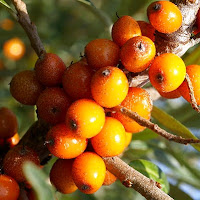Vitamin C is abundantly available in plant sources like fruits and vegetables
Kakadu plums - rich sources of vitamin C (3100 mg/100 gm)
Kakadu plums (Terminalia ferdinandiana) are the richest known sources of ascorbic acid.
These kakadu plum trees are medium sized and are tropical and native to Australia.
Kakadu plums are about 2 cm long and are almond-like.
Kakadu plums are green-yellow colored and have one large seed.
Kakadu plums have been found to contain even up to 5% ascorbic acid per plum by weight.
Camu Camu - rich in vitamin C (2800 mg/100 gm)
Camu camu (Myrciaria dubia) are the second richest sources of ascorbic acid containing up to 3000 mg per 100 gm.
Camu camu is a bushy tree found in the Amazon rain forests along the river side. Camu camu fruits are small, red and cherry like.
Camu camu gives high acidic taste and is consumed mixed with other food or diluents.
The processed powder of camu camu pulp has hit the market and it may start replacing synthetic sources of ascorbic acid.
Rose hips - rich in vitamin C (2000 mg/100 gm)
Rose hips are the fruits of the rose plant and they are orange-red in colour.
Rose hips are very rich, containing up to 2000 mg per 100 gm.
Rose hips of the species Rosa canina and R. majalis are particularly rich in vitamin C.
These bushy plants are also used as ornamental plants. Rose hips are used in the preparation of herbal tea.
Rose hips are also used in food preparations like jam. Rose hips also contain antioxidant flavonoids and essential fatty acids.

Acerola - rich in vitamin C (1600 mg/100 gm)
Acerola (Malpighia glabra) are small trees, bearing fruits with the appearance of cherry.
Acerola trees are found in the southern region of North America and South America.
Acerola is presently cultivated throughout the world. Acerola are small 1-3 cm drupes bright red in color.
Acerola are near acidic in taste with three seeds. Acerola contains up to 1600 mg of ascorbic acid per 100 gm.

Sea Buckthorn fruits - rich sources of vitamin C (700 mg/100 gm)
Seabuckthorn (Hippophae rhamnoides) are shrubs widespread in Asia and Europe.
The orange coloured berries contain 700 mg of vitamin C per 100 gm. The berries are acidic in nature.

Jujube fruits - rich sources of vitamin C (500 mg/100 gm)
Jujube or red date or Chinese date are the drupe fruits of the jujube shrubs (Ziziphus zizyphus). Jujube shrubs are widespread in Asia and have been introduced in Europe.
Jujube are eaten fresh or with sugar syrup. Jujube contains nearly 500 mg of ascorbic acid per 100 gm of fruits.
In Asia, jujube has a role in the cultural functions and traditional medicine.
Vitamin C in Indian gooseberry (450 mg/100 gm)
Indian gooseberry (Phyllanthus emblica) is a deciduous medium sized tree.
The Indian gooseberry are berries which are greenish yellow in color, round and hard.
Indian gooseberry is sour, astringent and bitter in taste.
Indian gooseberry is consumed raw or used in food preparations.
Indian gooseberry has been used in Indian traditional medicine for thousand years.
Indian gooseberry contains up to 500 mg of vitamin C per 100 gm of fruits.
Indian gooseberry also contains high levels of other antioxidants.

Vitamin C in Baobab fruits (400 mg/100 gm)
Baobab (Adansonia sp.) are found in Africa, Australia and Madagascar.
Baobab trees store water inside their trunk. Baobab fruits are nutritious containing up to 400 mg of vitamin C per 100 gm.
The dried pulp of baobab is eaten raw as well as used in various preparations. In certain parts of Africa juice of baobab is used.
Vitamin C in Blackcurrant (200 mg/100 gm)
Blackcurrant (Ribes nigrum) is small shrub growing in northern Asia and North and central Europe.
Blackcurrant fruits are rich in ascorbic acid, containing up to 200 mg per 100 gm.
Blackcurrant is a berry which is dark purple to black in color, measuring 1 cm in diameter.
Blackcurrant having sweet taste is used in a number of food preparations like salads, jams, jellies and syrups.

Vitamin C in Guava (100 mg/100 gm)
Guava (Psidium sp.) trees are native to Southeast Asia, Mexico, Central America and northern South America.
Guava trees are quite hardy and adaptable to colder regions.

Guava is eaten raw or used in food preparations like jam and salads.
Guava is rich in vitamin C and contains 100 mg per 100 gm.
Richest fruit sources of vitamin C.
No comments:
Post a Comment